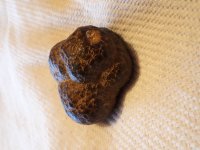You are using an out of date browser. It may not display this or other websites correctly.
You should upgrade or use an alternative browser.
You should upgrade or use an alternative browser.
✅ SOLVED Unusually heavy weird rock. Dinosaur poo?
- Thread starter TannersHatch
- Start date
Plug N Play
Bronze Member
- Aug 23, 2014
- 1,315
- 3,573
- Detector(s) used
- De Havilland Canada DHC-7-102 Dash 7 - Fugro
- Primary Interest:
- All Treasure Hunting
Botryoidal Hematite
Upvote
0
Red-Coat
Gold Member
Botryoidal Hematite
Agree. Contrary to popular belief, hematite itself is not magnetic. The only commonly found iron mineral which is attracted to a magnet is magnetite, so when other iron minerals are found to be magnetic it's because they also contain small amounts of secondary magnetite. Whether or not this is the case is a matter of chance, related to how they formed.
Ambergris is not a dense material. It starts off with a specific gravity close to 1 and usually gets lighter the longer it has been in the water... to the extent that it often floats.
Upvote
0
Plug N Play
Bronze Member
- Aug 23, 2014
- 1,315
- 3,573
- Detector(s) used
- De Havilland Canada DHC-7-102 Dash 7 - Fugro
- Primary Interest:
- All Treasure Hunting
He said, "not magnetic".
The TLDR is in red:
"Magnetism
Hematite shows only a very feeble response to a magnetic field. Unlike magnetite, it is not noticeably attracted to an ordinary magnet. Hematite is an antiferromagnetic material below the Morin transition at 250 K (−23 °C), and a canted antiferromagnet or weakly ferromagnetic above the Morin transition and below its Néel temperature at 948 K (675 °C), above which it is paramagnetic.
The magnetic structure of α-hematite was the subject of considerable discussion and debate during the 1950s, as it appeared to be ferromagnetic with a Curie temperature of approximately 1,000 K (730 °C), but with an extremely small magnetic moment (0.002 Bohr magnetons). Adding to the surprise was a transition with a decrease in temperature at around 260 K (−13 °C) to a phase with no net magnetic moment. It was shown that the system is essentially antiferromagnetic, but that the low symmetry of the cation sites allows spin–orbit coupling to cause canting of the moments when they are in the plane perpendicular to the c axis. The disappearance of the moment with a decrease in temperature at 260 K (−13 °C) is caused by a change in the anisotropy which causes the moments to align along the c axis. In this configuration, spin canting does not reduce the energy.[11][12] The magnetic properties of bulk hematite differ from their nanoscale counterparts. For example, the Morin transition temperature of hematite decreases with a decrease in the particle size. The suppression of this transition has been observed in hematite nanoparticles and is attributed to the presence of impurities, water molecules and defects in the crystals lattice. Hematite is part of a complex solid solution oxyhydroxide system having various contents of water, hydroxyl groups and vacancy substitutions that affect the mineral's magnetic and crystal chemical properties.[13] Two other end-members are referred to as protohematite and hydrohematite.
Enhanced magnetic coercivities for hematite have been achieved by dry-heating a two-line ferrihydrite precursor prepared from solution. Hematite exhibited temperature-dependent magnetic coercivity values ranging from 289 to 5,027 oersteds (23–400 kA/m). The origin of these high coercivity values has been interpreted as a consequence of the subparticle structure induced by the different particle and crystallite size growth rates at increasing annealing temperature. These differences in the growth rates are translated into a progressive development of a subparticle structure at the nanoscale. At lower temperatures (350–600 °C), single particles crystallize however; at higher temperatures (600–1000 °C), the growth of crystalline aggregates with a subparticle structure is favored"
Upvote
0
Top Member Reactions
-
 2318
2318 -
 1124
1124 -
 1043
1043 -
 898
898 -
 835
835 -
 778
778 -
 754
754 -
 740
740 -
 606
606 -
 507
507 -
 493
493 -
 475
475 -
 452
452 -
 421
421 -
 396
396 -
 394
394 -
O
393
-
 387
387 -
 383
383 -
 374
374
Users who are viewing this thread
Total: 2 (members: 0, guests: 2)





